
Some moments on this planet are so rare, so beautifully unpredictable, they feel like nature’s way of rewarding the lucky and the curious. They don’t happen every day—or every year. You need to be in the right spot, at the right time, with a little bit of patience and a whole lot of wonder.
These aren’t your typical travel bucket list items. They’re the fleeting phenomena most people never get to see in their lifetime. But you could. And once you do, they’ll mark you forever. Because when nature decides to show off, there’s truly nothing else like it.
1. Bioluminescent Waves – Mosquito Bay, Puerto Rico

There’s magic in the water at night in Mosquito Bay — literally. When the sun dips below the horizon, the shoreline of Vieques Island begins to glow with a bluish-green light every time the water is disturbed. This isn’t CGI or a trick of the eyes — it’s the result of dinoflagellates, microscopic organisms that produce light when agitated. You dip your hand in, and the ripples light up like stardust. It feels otherworldly — like you’re standing inside a living galaxy.
What makes Mosquito Bay even more special is its concentration of these glowing plankton — the highest density of bioluminescent organisms in the world, according to the Guinness World Records. Paddle through the bay in a clear-bottom kayak, and each stroke leaves a glowing trail behind, while fish darting beneath the surface leave streaks of blue light. It’s so vivid, you can see the glow outlining your silhouette.
The phenomenon occurs year-round, but it requires very dark conditions to fully appreciate. That means new moon phases are best, and the glow is much brighter on nights with little to no cloud cover or light pollution. Weather plays a role too — hurricanes and heavy rainfall can temporarily disrupt the glowing algae, but they always return in time.
Quick Facts:
- Best Months to Visit: December to April (dry season)
- Best Time of Month: Around the new moon
- How to See It: Clear-bottom kayak tour or guided night swim
- Don’t Miss Tip: Avoid using bug spray with DEET — it harms the bay’s delicate ecosystem
2. Aurora Borealis – Tromsø, Norway

The Northern Lights are not just a bucket list item — they’re a full-body experience. The sky comes alive with swirling curtains of green, pink, and sometimes purple light, pulsing in rhythm like a cosmic heartbeat. In Tromsø, you’re in the sweet spot of the auroral oval, giving you one of the best and most reliable chances to witness this dazzling spectacle.
What makes Tromsø so extraordinary is its combination of latitude, clear skies, and accessibility. It’s a modern city with all the comforts, but step just 15 minutes outside of town and you’re in untouched Arctic wilderness, perfect for uninterrupted sky-gazing. Locals often say you’ll never forget your first aurora — not because of the color or size, but because of how it makes you feel: small, yet incredibly lucky to be in the right place at the right time.
Auroras are a solar phenomenon, triggered by particles from the sun colliding with Earth’s magnetic field. So the display isn’t just visual — it’s a direct result of deep-space forces. That’s why forecasts matter, and apps or local guides can help you chase the lights on the best nights. A clear, cold evening in Tromsø during aurora season is like nature’s own grand performance.
Quick Facts:
- Best Months to Visit: September to March
- Peak Viewing Hours: 9:00 PM to 2:00 AM
- Best Conditions: Cold, clear skies with low light pollution
- Getting There: Fly to Tromsø; many guided tours available for aurora hunting
3. Sailing Stones – Racetrack Playa, California, USA
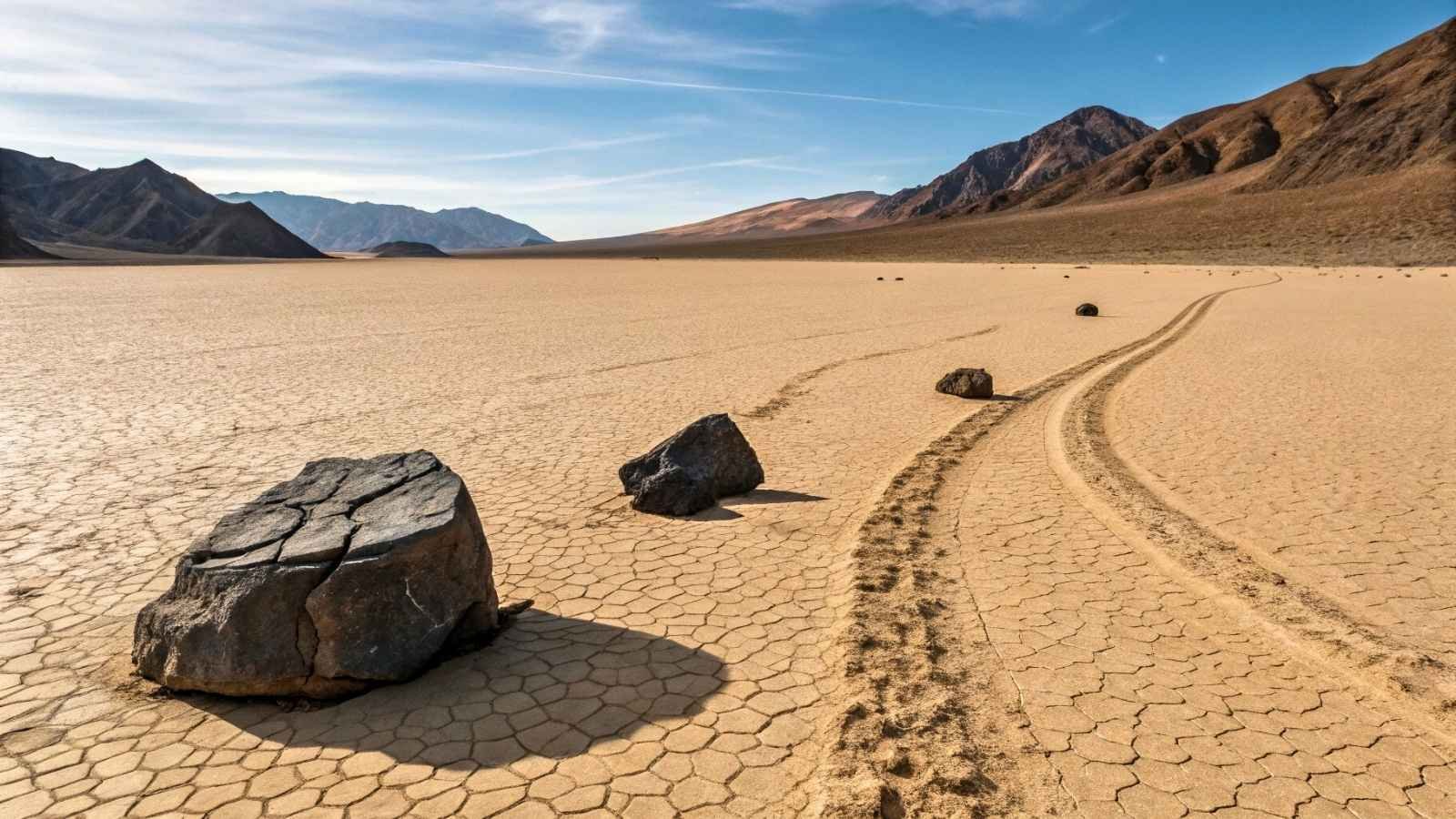
In the heart of Death Valley National Park, there’s a flat, cracked lakebed where rocks — some weighing hundreds of pounds — mysteriously move across the desert floor, leaving trails behind them as if they’ve sailed through the mud. No footprints. No animals. No obvious slope. Just long, winding tracks that suggest movement where none should exist.
For decades, the mystery has puzzled scientists and visitors alike. Were the rocks pushed by wind? Did pranksters move them? In 2014, time-lapse research finally revealed the answer: a perfect combination of rain, freezing temperatures, and wind causes thin sheets of ice to form under the stones. As the sun rises and the ice begins to melt, wind pushes the rocks ever so slowly, creating their ghostly trails. It only happens every few years, and you have to be lucky enough to catch it in action.
But even if you don’t witness the rocks moving, seeing the trails and understanding what created them is still surreal. The setting — an arid, silent desert with cracked clay beneath your feet and stone trails etched into the earth — feels like you’re walking across another planet.
Quick Facts:
- Best Months to Visit: December to February (cooler and more likely to rain/freeze)
- Best Time of Day: Early morning, after a rare desert freeze
- Access: 27-mile dirt road from Furnace Creek; high-clearance vehicle recommended
- Bonus Tip: Check weather patterns before you go — movement only happens after rain + freeze
4. Moonbow at Victoria Falls – Zambia/Zimbabwe
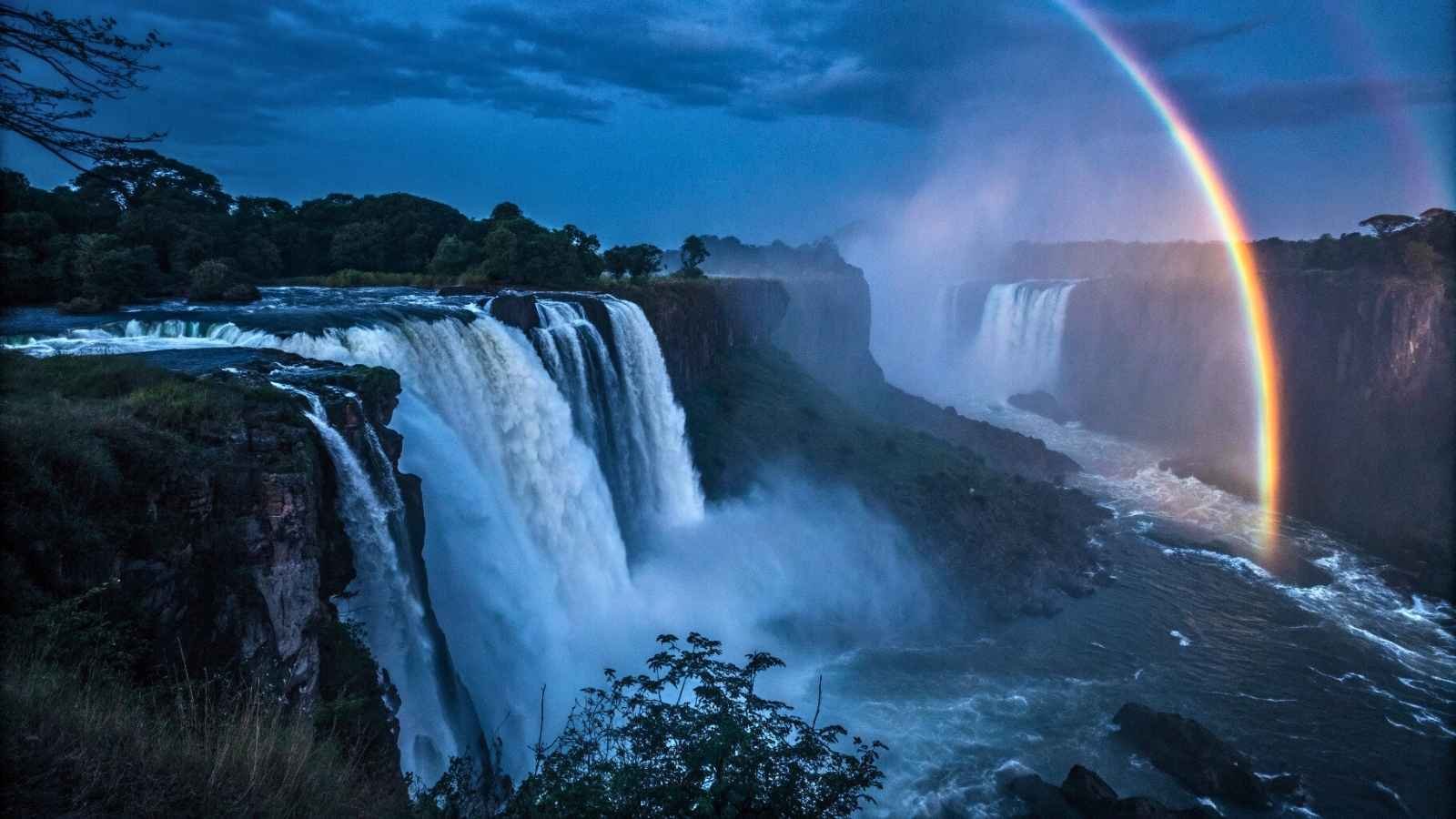
By day, Victoria Falls is thunderous and powerful. But by night — during the full moon — something extraordinary happens: a moonbow appears in the mist. Unlike a daytime rainbow, this one is formed by moonlight refracting through water droplets, casting a soft, silver arc that’s barely visible to the naked eye but can be captured clearly on long-exposure cameras.
Few places on Earth offer the right conditions for this kind of lunar rainbow, and Victoria Falls is one of the most consistent and dramatic. The mist thrown up by the falls, combined with the intense African moonlight, creates an ethereal light show — ghostly, quiet, and hauntingly beautiful. You can’t quite believe it until you see it, and even then, it feels like a secret nature lets you in on once in a blue moon — literally.
There’s something deeply romantic and mysterious about watching a rainbow that only reveals itself at night. The moonbow is best seen from the Zimbabwean side of the falls, particularly at spots like Lunar Rainbow Point in the national park. Park authorities even open the gates for special night-time viewings during full moon periods.
Quick Facts:
- Best Months to Visit: March to July (when the water flow is high)
- Best Time of Month: Full moon nights
- Entry: Victoria Falls National Park offers special moonlight access passes
- Photography Tip: Bring a tripod — long exposure is key to capturing it clearly
5. Frozen Methane Bubbles – Abraham Lake, Canada
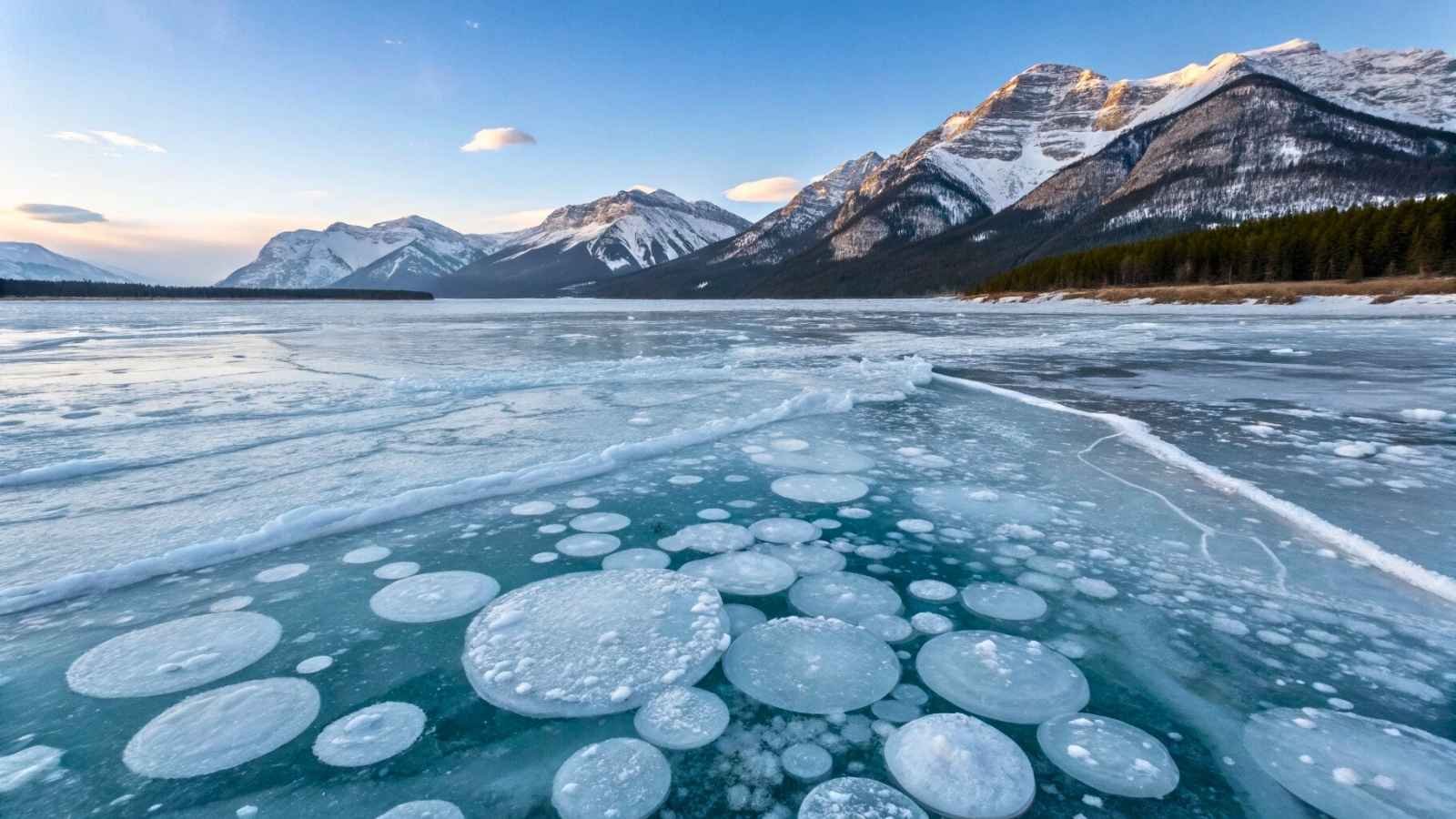
You’ve probably seen the photos: frozen lakes with perfectly trapped white bubbles suspended beneath the surface like frozen pearls. What you’re looking at is methane gas released by decaying plants at the lake bottom, caught mid-rise in the freezing water. It’s eerie, stunning, and only occurs under very specific winter conditions. One of the best places to see it? Abraham Lake in Alberta.
This artificial lake isn’t just visually dramatic — it’s backed by craggy mountains, blue skies, and the occasional winter mist that gives it an otherworldly glow. The bubbles themselves stack in layers, sometimes dozens deep, and the clarity of the lake ice means you can see every detail. Walk across it and you’ll hear cracking sounds beneath your boots, reminding you just how precarious — and unique — the moment is.
Although the phenomenon is breathtaking, it’s also a reminder of how climate and ecology intersect. Methane is a potent greenhouse gas, and while the frozen version is stunning, its release has long-term implications for our planet. But standing on that glassy surface, surrounded by silence and snow, you’re simply lost in the beauty of a moment that very few people ever get to see.
Quick Facts:
- Best Months to Visit: Late December to early February
- Best Conditions: Cold, dry winters with minimal snowfall for clear ice visibility
- Access: Located in Alberta’s David Thompson Country, best reached by car
- Safety Tip: Always check ice thickness before venturing far from shore
6. Volcanic Lightning – Sakurajima, Japan
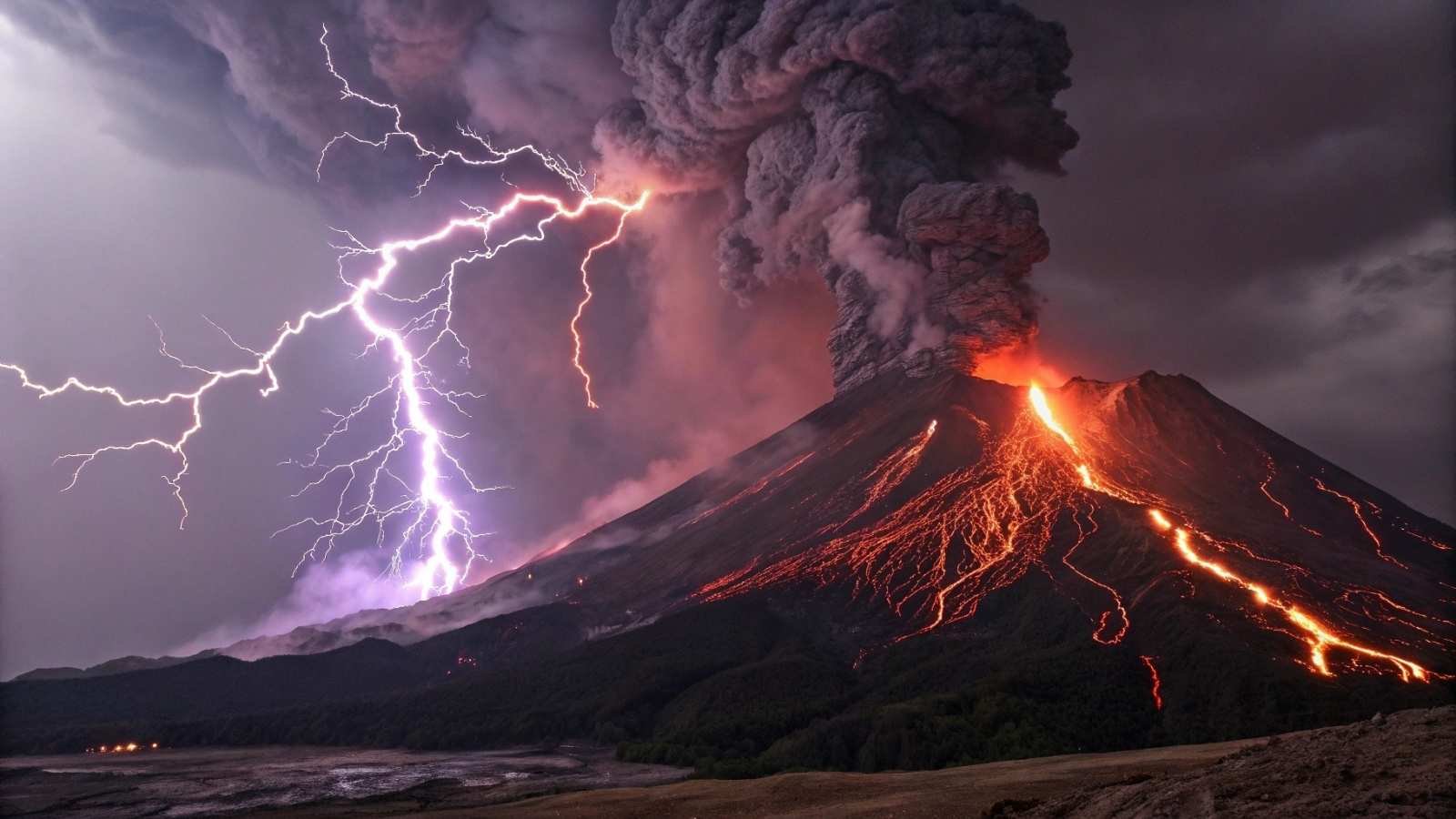
You’ve seen thunderstorms and you’ve heard of volcanic eruptions — but when the two combine, the result is something straight out of a fantasy novel: volcanic lightning. At Sakurajima Volcano, off the southern coast of Japan, eruptions frequently generate lightning storms within the ash cloud. It’s one of the few places on Earth where you can witness this phenomenon reliably, especially during heightened activity.
Here’s how it works: when the volcano erupts, it sends massive amounts of ash and gas into the air. The tiny particles collide and build up static electricity, which then discharges as bolts of lightning, often with no rain in sight. The sky flashes purple or white against a backdrop of ash and fire — it’s both terrifying and mesmerizing. You don’t need to be close to feel its power; just seeing it from a safe viewing area gives you chills.
Sakurajima is one of the most active volcanoes in the world, but it’s closely monitored. There are designated observation points in Kagoshima, and when activity spikes, locals know where to go to watch from a safe distance. This isn’t an everyday event, but when conditions line up, it’s something you’ll never forget.
Quick Facts:
- Best Months to Visit: Year-round, but July to December sees higher volcanic activity
- Best Time of Day: Nighttime, for maximum lightning visibility
- Viewing Spot: Arimura Lava Observatory or Yunohira Observatory
- Safety Tip: Monitor Japan Meteorological Agency updates before planning a trip
7. Firefall – Horsetail Fall, Yosemite, USA

For most of the year, Horsetail Fall is just one of Yosemite’s many seasonal waterfalls. But for a brief window in mid to late February, something miraculous happens: the setting sun hits the waterfall at just the right angle, making it glow like molten lava. Locals call it the “Firefall”, and for good reason — it looks like the mountain is pouring liquid fire down its granite face.
What makes this phenomenon so rare is the timing and the alignment. You need clear skies, adequate water flow, and perfect sunlight conditions all at once. When it happens, though, it feels like a reward for patience. Photographers line up hours in advance, hoping for that golden, fiery glow that lasts just minutes. It’s not guaranteed, but when it appears, the whole valley gasps.
It’s a humbling reminder of how nature doesn’t perform on command — and that’s exactly why it’s so special. No light show, no national park brochure, no video can do it justice. You have to be there, standing in the cold twilight, watching the stone come alive with color.
Quick Facts:
- Best Dates to Visit: February 10–25, peaking around February 18–22
- Best Time of Day: Just before sunset, around 5:30–6:00 PM
- Viewing Locations: El Capitan picnic area or Southside Drive pull-offs
- Pro Tip: Arrive early in the afternoon to claim a spot — it gets crowded fast
8. Starling Murmuration – Somerset Levels, UK

At first, it’s just a few birds. Then hundreds. Then thousands of starlings take to the sky, swirling and twisting in enormous, shape-shifting clouds that move like they’re dancing to a silent rhythm. This natural aerial ballet is called a murmuration, and one of the best places on Earth to witness it is the Somerset Levels in southwest England.
What’s amazing isn’t just the size of the flocks — sometimes over 100,000 birds — but the fluid coordination. No leader, no script, just instinct guiding them in real-time patterns that morph into hypnotic waves and spirals. Scientists believe murmurations help protect the birds from predators, confuse hawks, and help them find safe roosting spots. For the rest of us, they’re just one of the most mesmerizing things you can ever watch unfold in the sky.
To catch a murmuration, timing is everything. The birds gather in the late afternoon during autumn and winter, particularly as the sun sets. The air chills, the sky turns golden, and the birds begin their dance. There’s no music, but somehow, it feels like a symphony anyway.
Quick Facts:
- Best Months to Visit: November to February
- Best Time of Day: Just before sunset
- Best Spot: RSPB Ham Wall Nature Reserve, Somerset
- What to Bring: Binoculars, warm layers, and a camera with a fast shutter
9. Lake Natron’s Red Waters – Tanzania
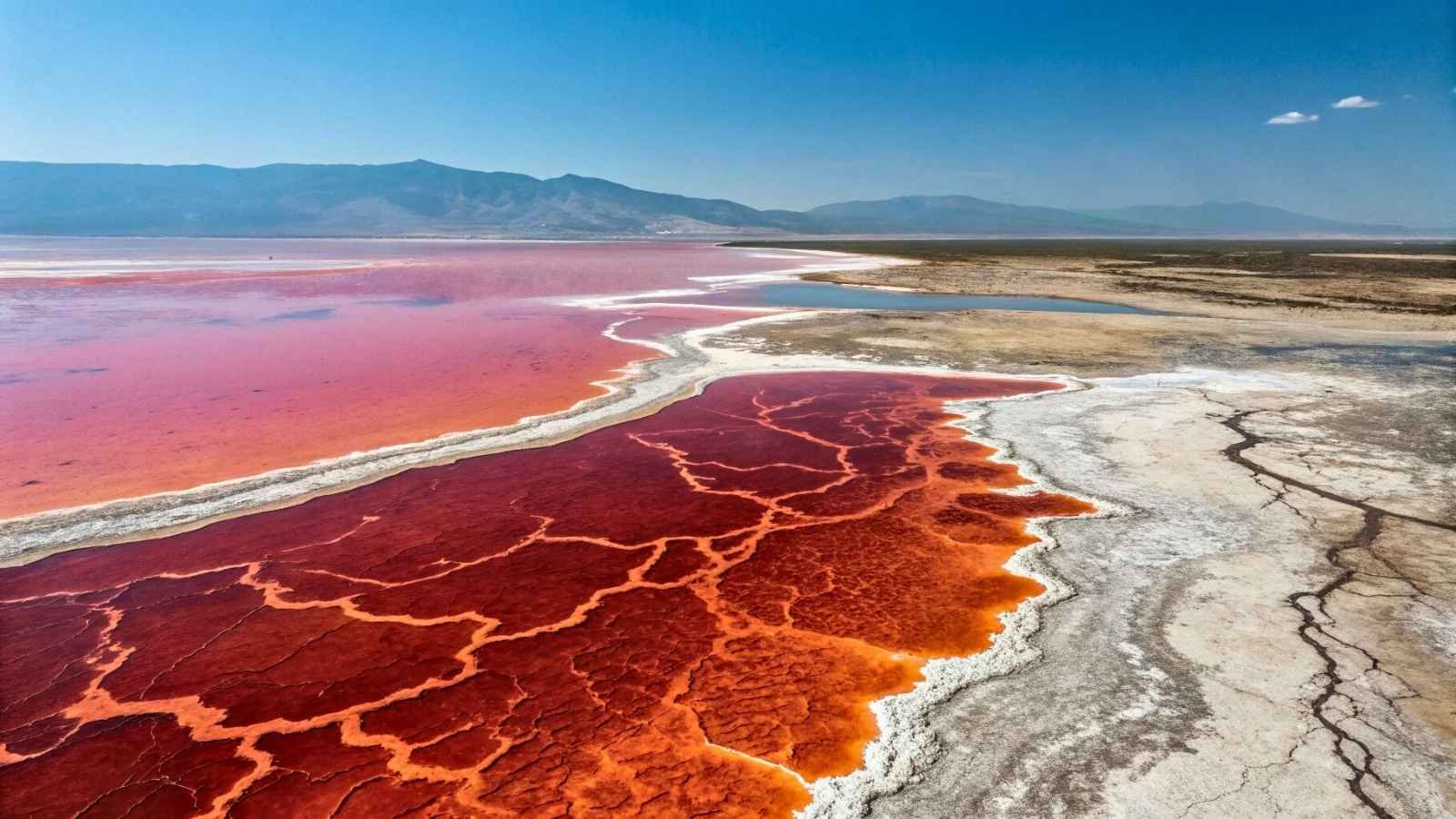
It looks like something out of a dystopian sci-fi film: a lake stained deep crimson, scattered with calcified animal remains. Lake Natron, near the Kenya-Tanzania border, owes its color and eerie appearance to high concentrations of salt, alkalinity, and microorganisms that thrive in extreme conditions. Under the right lighting, especially during the dry season, the lake’s surface turns a vivid red or orange.
As strange as it looks, the lake is a critical ecosystem, especially for lesser flamingos, which use it as a breeding ground. The water’s high alkalinity deters predators, giving the birds a haven. But for most other species, the lake is lethal. Animals that fall in often become calcified by the minerals, creating the lake’s infamous “statues.”
This is one of those surreal places where beauty and danger co-exist. It’s not a tourist hotspot in the traditional sense, but for those who venture to its shores, Lake Natron offers views — and colors — you won’t find anywhere else on Earth.
Quick Facts:
- Best Months to Visit: June to October (dry season, flamingo nesting)
- Best Time of Day: Late afternoon, for peak coloration under sunlight
- Access Point: Base camp at Engaresero village, then guided hikes
- What to Bring: Sunscreen, good hiking boots, and a zoom lens
10. Spotted Lake – British Columbia, Canada

As summer heats up in British Columbia’s Okanagan Valley, a strange transformation takes place. Spotted Lake, near the town of Osoyoos, evaporates in patches, leaving behind a field of circular spots — each a different shade of green, yellow, or blue. These spots are highly concentrated mineral pools, formed as the lake water recedes and the salts crystallize.
This surreal landscape isn’t just beautiful; it’s sacred to the Syilx First Nations people, who have long revered the lake for its healing properties. The colors vary depending on the mineral composition and time of year — magnesium, calcium, and sulfates each create a different hue. From the roadside lookout, the lake looks like a mosaic or an artist’s palette — nature’s own abstract painting.
While the lake is closed to foot traffic to protect its fragile crust and cultural significance, you can still get an incredible view from the highway. It’s one of those natural oddities that feels like a quiet secret — a place that changes with the sun, the season, and your perspective.
Quick Facts:
- Best Months to Visit: Late July to early September
- Best Time of Day: Midday, when the sun is high for color contrast
- Access Tip: View from Highway 3, west of Osoyoos
- Note: No walking access; the lake is protected and privately managed
11. Great Sardine Run – South African Coast

This isn’t just a migration — it’s a full-on underwater stampede. Every year between May and July, billions of sardines travel up the eastern coast of South Africa, forming massive shoals that stretch for miles. It’s one of the largest marine biomass movements on Earth, and with it comes an entourage of hungry guests — dolphins, sharks, whales, and seabirds, all diving into the frenzy.
The energy is wild and chaotic. Dolphins herd sardines into tight balls, sharks barrel through with open jaws, and gannets plummet from the sky like missiles. Divers call it “The Blue Serengeti” — a symphony of motion and instinct that you can’t fully grasp until you’re in the water, surrounded by silver flashes and a sense that the ocean itself is vibrating with life.
Whether you’re a diver, a snorkeler, or just watching from a boat, the Sardine Run is like a live-action wildlife documentary, except you’re in the middle of it. No narration needed — just adrenaline, awe, and the cold bite of the Indian Ocean.
Quick Facts:
- Best Months to Visit: June to early July
- Best Locations: Port St. Johns, Coffee Bay, East London
- How to See It: Diving safaris or boat tours — operators run seasonal packages
- Tip: Book early — limited windows and high demand for underwater access
12. Blue Volcano – Kawah Ijen, Indonesia

At first glance, Kawah Ijen looks like your average smoldering volcano. But come nightfall, it reveals one of the planet’s most visually surreal events: blue flames spilling out of the crater. Caused by sulfuric gases igniting as they escape cracks in the rock, these electric-blue flames snake along the darkened ground like liquid neon fire.
It’s not a trick of the light — it’s a real combustion event, and one that few places on Earth produce. You need just the right mix of heat, gas pressure, and oxygen, and even then, it’s only visible in total darkness. A pre-dawn hike to the rim is both challenging and unforgettable — you pass miners carrying baskets of raw sulfur on their backs, glowing in headlamp beams like ghosts on a mountain.
Even if you’re not a chemistry buff, this phenomenon makes science feel like magic. And the kicker? Right after the flames fade with the sunrise, you’re greeted by a turquoise-acidic crater lake, adding another layer of strangeness to the whole experience.
Quick Facts:
- Best Months to Visit: May to September (dry season)
- Best Time of Day: 1:00 AM to 4:00 AM, before sunrise
- Access Point: Banyuwangi, East Java — guided hikes recommended
- Safety Note: Sulfur gas is hazardous — wear a proper gas mask, not a simple face covering
13. Blooming Desert – Atacama Desert, Chile

A desert is supposed to be lifeless, right? Not always. Every few years, after an unusually rainy winter, Chile’s Atacama Desert — one of the driest places on Earth — explodes in color. Flowers bloom across the arid ground in shades of purple, yellow, and white, creating what locals call “Desierto Florido” (the flowering desert).
The contrast is startling. For most of the year, the Atacama looks like the surface of Mars — dry, silent, and stark. But when the bloom happens, it’s as if nature is making up for lost time. Fields of wildflowers stretch to the horizon, bees buzz, and butterflies drift in the breeze. It only lasts a few weeks, and you never know exactly where it will hit, making each bloom a bit of a scavenger hunt for photographers and nature lovers.
There’s something poetic about it. A place defined by absence suddenly becomes a burst of fragile beauty. It’s a gentle reminder that even the most barren landscapes hold potential, if given the right moment to shine.
Quick Facts:
- Best Months to Visit: September to early November, after unusually rainy winters
- Best Regions: Near Copiapó, Vallenar, and Parque Llanos de Challe
- How Often It Occurs: Irregular — roughly every 3–7 years
- Tip: Monitor Chilean meteorological reports for rainfall patterns in advance
14. Green Flash at Sunset – Key West, Florida, USA
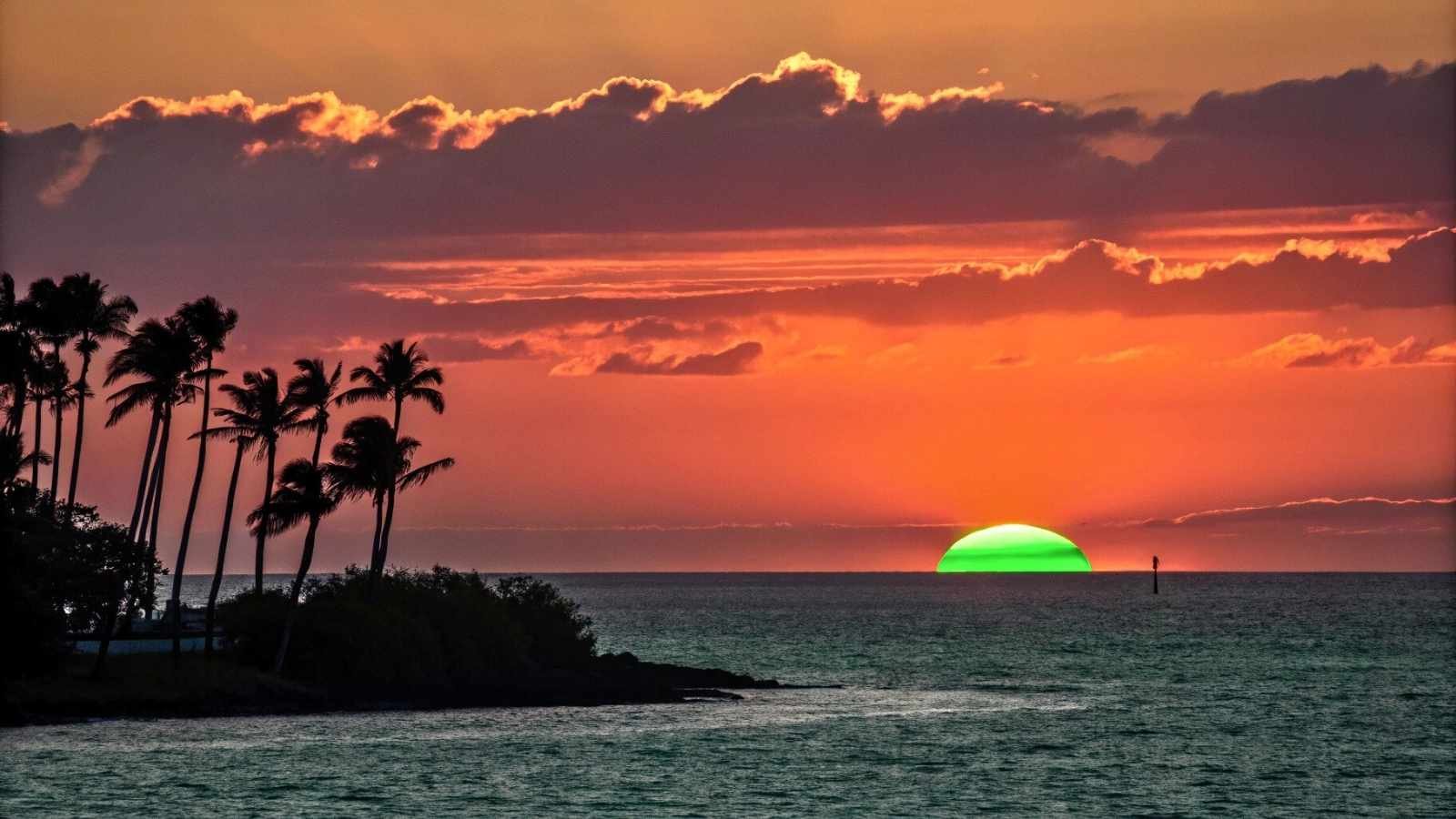
Blink and you’ll miss it — literally. The green flash is one of those phenomena that almost feels like folklore: just as the sun dips below the ocean, a brief burst of emerald light appears at the top edge. It lasts a second or two at most, but for those watching, it feels like time stops.
This optical illusion is caused by light refraction in the Earth’s atmosphere. The conditions have to be just right: a clear, unobstructed horizon, no haze, and very stable air. Key West is one of the few places in the U.S. where these conditions align often enough to give you a real shot at seeing it, especially from places like Mallory Square, where crowds gather for sunset every night.
You’ll hear gasps, cheers, even silence when the flash occurs. It’s not guaranteed, and that makes it all the more thrilling. Like nature’s own version of “now you see it, now you don’t.”
Quick Facts:
- Best Months to Visit: March to May and September to November
- Best Time of Day: The Last few seconds before sunset
- Best Viewing Spot: Mallory Square or Higgs Beach Pier
- Watching Tip: Use binoculars to increase your odds, but never look directly at the sun without protection
15. Migration of Red Crabs – Christmas Island, Australia

It’s one of the weirdest, most charming mass movements in the natural world. Each year, more than 50 million bright red land crabs emerge from the rainforest and scurry en masse across Christmas Island, heading for the ocean to breed. Roads shut down, signs go up, and special crab bridges are deployed — the entire island pivots to accommodate this crab-pocalypse.
They’re surprisingly fast, surprisingly loud (yes, you can hear the rustling), and surprisingly… adorable. What makes this event so unique is not just the scale, but how completely integrated it is into human life there. Locals celebrate it, visitors flock to see it, and you’ll find yourself oddly emotional watching thousands of crabs pour across roads and trails in unison, all guided by instinct and moonlight.
The migration is tied to the lunar calendar, usually peaking after the first heavy rains in October or November, but timing varies slightly year to year. If you want to catch it, you’ll need to plan smart — and maybe brush up on your crab-spotting skills.
Quick Facts:
- Best Months to Visit: October to December (around the first wet-season rains)
- Peak Activity: Just after the full moon
- Best Viewing Areas: Drumsite, Hugh’s Dale, and Ethel Beach tracks
- Insider Tip: Bring shoes you don’t mind getting pinched — they’re everywhere






